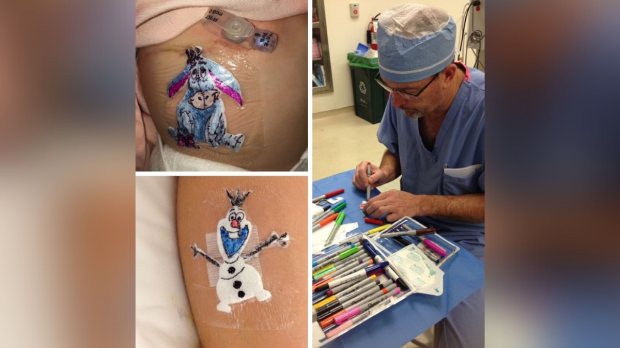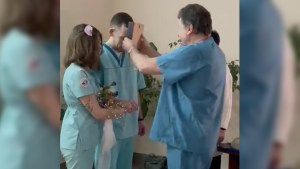Dr. Robert Parry is a surgeon who does his best to keep children from being upset about their surgeries. To help them, he puts down his scalpel after surgery and picks up a marker, drawing amazing cartoon characters on their dressings. And when the kids wake up, the wounds don’t bother them so much!
Going to the hospital for surgery is often a scary event, especially for children. Dr. Parry came up with the idea to slightly disperse his little patients’ post-operative stress using an unusual and creative method.
The Director of Pediatric Surgery at Akron Children’s Hospital pulls out his colorful markers and draws funny cartoons on their bandages. His drawings have inspired enthusiasm in people across the country.
“I like to feel like I’m giving them something that I’ve spent some time on, to tell them, ‘You’re not just someone I’ve operated on. You’re actually a human being. Here’s a little piece of me with it,” he says in a video shared on Facebook.
“I love medicine and helping people.”
On the Akron Children’s Hospital Facebook page, a post explains that Dr. Robert Parry “takes a moment to make sure a scar isn’t the only lasting memory of a child’s surgical procedure. He surprises them with a hand-drawn dressing featuring a character or something that personally interests them.”
The technique is effective; a CNN report mentions the case of a young girl who had had an operation at the age of seven. “The doctor told Kennedy and her siblings she would have a lovely butterfly after she was done. When Kennedy came out, everyone was excited to see what the doctor meant. Kennedy was so proud of the pretty bandage and not concerned about any scars,” the girl’s mother, Christina Potts Whipkey, told CNN.
“Whenever one of my kids arrives in the recovery room, the nurses all like to take a look to see what dressing the child got. I think it just makes everyone, me included, feel good,” Dr. Parry said.
Where did this idea come from? The doctor explained to cafemom that he was inspired by a colleague, Dr. Perry Stafford, who cut bandages in the shape of hearts or animals. The unusual shapes always made young patients smile. Robert really liked them and decided that he would create his own “dressing art” for his little patients.
Two passions
He developed his own method that allows him to add colorful art while keeping the wounds sterile. Parry explains to cafemom’s Genny Glassman that he has always been interested in art, but eventually decided to study medicine. His mother was an art historian and amateur artist.
The surgeon says he doesn’t see much difference between his two passions. “Working as a surgeon and his drawings have both allowed him to work with his hands—and make people feel better in the process,” Glassman writes. Dr. Parry concludes, “I guess, then, that it’s not a surprise that I gravitated toward surgery. I loved medicine and helping people, but surgery let me use both my mind and my hands.”
The doctor tells cafemom that he enjoys working with children. “Kids are just fun to be around, there is so little judgment and they just want to be happy and feel better. And, honestly, it’s incredibly rewarding to help a child survive and have the opportunity to grow up healthy,” Parry emphasizes.
He adds that little ones are incredibly strong and, despite suffering, they enjoy beautiful things, even if the situation around them isn’t really that wonderful.
Dr. Parry doesn’t take long to do the drawings. “Most dressings are done within five minutes while the patient is waking up,” he tells cafemom’s reporter. “If I’m slow, I just walk to the recovery room and put it on there. The response is really wonderful. The child gets distracted and excited to see what they asked for, the parents are happy, and the medical staff is happy.”
Since completing his training in pediatric surgery in 1996, Robert has made sure that every patient he operated on went home with a cheery picture. “I’ve operated on more than 10,000 children, and all of them that needed a dressing got a drawing. From tiny newborns that weigh less than a pound to fully grown young adults. And I can’t recall anyone not enjoying it—no matter how old they are,” says the doctor.


